
My concerns on the near-term outlook for stocks were underscored last week when parcels giant Fedex warned that 2009 would remain “extremely difficult”. So for now, I suggest sticking with defensive sectors, such as healthcare.
This is because valuations are historically cheap and the long-term trends of ageing populations, personalised medicine and rising incomes in emerging markets are still intact.
In America, the World War II baby-boomer generation now makes up an estimated 25% of the population. Around half of them are over 65 and require greater medical assistance.
But it’s not all plain sailing for big pharma, which faces tighter regulatory scrutiny and $235bn-worth of drug patent expiries over the next six years. Another dark cloud for investors is Barack Obama’s healthcare reform plans.
His aim is to extend coverage of the government’s schemes to more of the nation’s 46 million citizens who are currently uninsured. The total cost is put at around $1trn over ten years. This will be funded by a combination of cuts to healthcare spending ($620bn) and tax hikes on high-earners ($318bn).
Kindred Healthcare (NYSE: KND), rated BUY by Soleil
This is bad news for managed care organisations, such as private hospitals, who conduct many of the treatments bought by the government. It might be a boon to makers of low-cost generic medicines. Why am I telling you this? Well, as often occurs at these junctures, the adrenaline junkies on Wall Street have gorged on the perceived beneficiaries while mercilessly hammering the supposed victims.
Take Kentucky-based Kindred Healthcare, whose shares are down 50% since last summer. It runs 82 acute care hospitals, 228 nursing centres and a patient rehabilitation business across the US. The hospitals unit is the top domestic player, with $1.9bn sales, of which 74% are made under long-term government deals.
The unit treats patients with critical conditions, such as multiple organ failure, severe wounds or dangerous infections. The average length of stay is 32 days per patient, of which 62% are over 65, generating bed occupancy rates of 65%.
Its nursing centres unit is number two in its field. Sales are $2.2bn, and occupancy rates at 89% reflect its more elderly customer profile (it focuses on those suffering from Alzheimer’s or other forms of dementia). The smallest of the three units, the rehabilitation business (sales $427m), provides specialised physical, occupational and speech therapies.
With the uncertainty over Obama’s plans, especially as regards reimbursement rates for treatment centres, Kindred’s investors have taken flight. Yet despite these fears, last month the board said the firm would achieve underlying 2009 earnings per share (EPS) of between $1.35 and $1.45 on revenue of $4.4bn.
That doesn’t yet factor in the latest proposals, but I reckon this will shave off 40 cents per share at worst – and that’s assuming there are no volume uplifts from the lower prices. Indeed, further out I’m sure the extra government demand will raise turnover, cut bad debts and raise occupancy levels. And with technology improving all the time, much of this margin squeeze could even be recouped through better purchasing and efficiency.
So how much is the group worth, weighing up the excellent demographics, offset by the lower reimbursement rates? Assuming organic growth of mid-to-single digits and Ebitda margins of only 5%, then Kindred should be able to achieve 2011 turnover and underlying EPS of circa $4.8bn and $1.6 respectively.
I’d value the group on a 14 times earnings multiple. After discounting back at 12%, that produces a fair value of around $17 a share. The robust balance sheet has net debt of only $220m, verses net tangible assets of $802m (or $20.50 a share).
Recommendation: BUY at $11.85
• Paul Hill also writes a weekly share-tipping newsletter, Precision Guided Investments